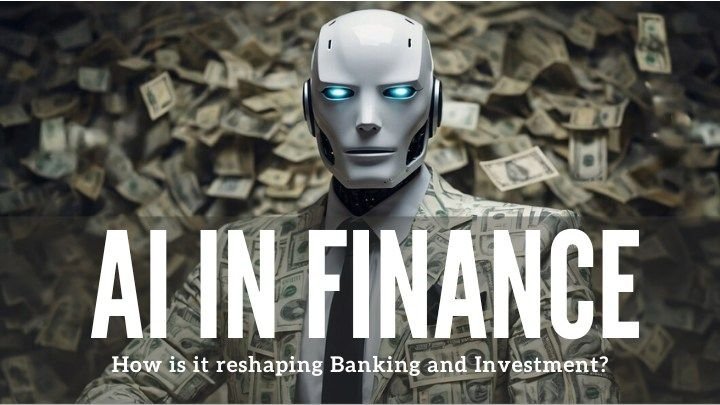When most people think of finance, they picture suits, spreadsheets, and maybe someone shouting “Buy!” on the stock exchange floor. But the truth is, the people making decisions about your money might not be people at all. Increasingly, it’s algorithms quietly deciding who gets a loan, when to flag fraud, or how to shuffle millions of dollars around in milliseconds.
I still remember the first time my debit card got declined during a trip abroad. I thought I was broke, but nope—the bank’s AI system flagged my purchase as “suspicious.” Annoying? Yes. Life-saving against fraud? Also yes. That’s AI in finance: invisible, powerful, sometimes irritating, but mostly unavoidable..
What Do We Mean by “AI in Finance”?
At its core, it’s the use of machine learning, automation, and data analysis to do what bankers, analysts, and traders have always done—only faster and with fewer coffee breaks.
Think of it as moving from a tired accountant crunching numbers at 11 p.m. to a system that can analyze billions of transactions while you’re still brushing your teeth. AI doesn’t replace the entire financial industry, but it automates and optimizes huge parts of it.
A Quick Journey: From Abacus to Algorithms
Finance has always been quick to grab new tools. The abacus, the calculator, Excel spreadsheets—each changed the game. But the real turning point came with algorithmic trading in the ’90s. Suddenly, computers weren’t just helping—they were competing.
Fast forward: credit card companies rolled out fraud detection powered by AI, investment firms built predictive models, and now, your banking app probably has more AI inside it than your old laptop.
How It Works (Without the Buzzwords)
Let’s strip away the jargon. Here’s what’s really happening behind the curtain:
Data digestion: Every swipe, trade, or loan request feeds into models.
Pattern spotting: The system compares your activity against millions of others—“Does this look normal?”
Prediction: It estimates risk—whether that’s a default on a loan or tomorrow’s likely stock movement.
Decision nudging: Instead of saying “yes” or “no,” it often recommends actions to humans (or, in trading, acts automatically).
If you’ve ever gotten an instant loan approval or a fraud alert within 30 seconds, that wasn’t a fast banker—it was AI.
The Shiny Benefits (From a User’s Point of View)
Fraud defense that actually works: Most of us only notice AI in finance when it blocks a sketchy transaction.
Faster decisions: Loans, insurance claims, approvals—things that once took weeks now sometimes take minutes.
Personalized advice: Banking apps suggesting savings goals or robo-advisors recommending investments aren’t random—they’re learning from your behavior.
Cheaper services: Automation means banks can scale without hiring an army of analysts, which (in theory) lowers costs.
The Not-So-Pretty Side
Bias baked into the system: If an algorithm is trained on biased data (say, lending practices that historically excluded certain groups), it can quietly continue the same discrimination.
The “black box” problem: Even bank employees can’t always explain why an AI approved one loan and denied another. Imagine being rejected with no explanation beyond “the system said no.”
Over-automation: In 2010, a trading algorithm glitch caused the infamous “Flash Crash,” wiping nearly a trillion dollars in minutes before stabilizing. That’s what happens when machines move faster than humans can react.
Privacy concerns: Finance AI thrives on personal data. The trade-off is convenience for you, but also massive amounts of sensitive data in corporate hands.
Real-World Use Cases (Where You’ve Probably Seen It)
PayPal & Stripe: Spot fraud in real time.
Wealthfront & Betterment: Robo-advisors building investment portfolios.
JPMorgan Chase: Their COIN platform reviews contracts that used to eat up 360,000 lawyer hours annually—now done in seconds.
American Express: Predicts credit risks and flags dodgy purchases before you even notice.
This isn’t futuristic—it’s been here for years, hiding in plain sight every time you swipe your card.
—
Where This Is Heading
We’re talking apps that not only track your spending but negotiate your bills, recommend tax-saving moves, and even auto-adjust investments the second markets twitch.
On a bigger scale, central banks are experimenting with AI to manage digital currencies and oversee financial stability. The irony? The very tools meant to reduce risk could, if unchecked, become sources of instability themselves.
My Two Cents
Here’s the part most corporate blogs won’t say: AI in finance isn’t magic—it’s math dressed in buzzwords. And while it’s good at detecting patterns, it struggles with human irrationality. Markets don’t always move logically; they move because people panic, get greedy, or, as we’ve seen recently, unite around meme stocks.
FAQs
Q: Can AI beat the stock market?
Sometimes, but not consistently. Even the best models can’t fully predict human behavior.
Q: Are robo-advisors safe to use?
Yes, for simple portfolios. But for complex wealth planning, a human advisor still has value.
Q: Does AI make banking fairer?
Not always. If the data is biased, the AI can be biased too.
Q: Could AI trigger another financial crisis?
If left unchecked, yes. Automated systems can magnify problems at lightning speed.
Q: Is my financial data safe?
Safer than before in some ways, but you’re still handing over a digital goldmine. Always read the fine print.
